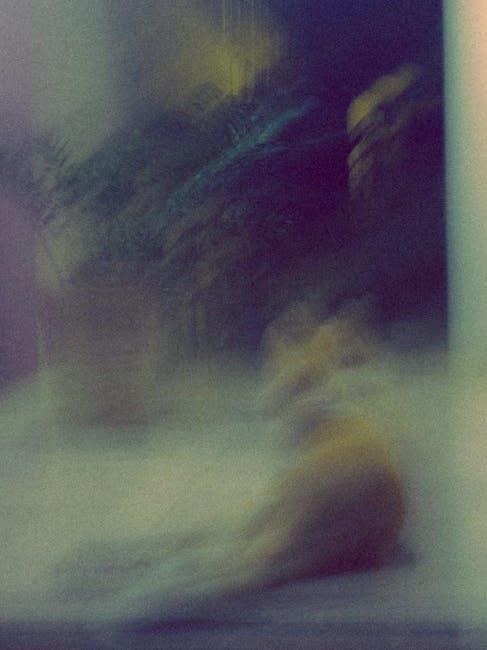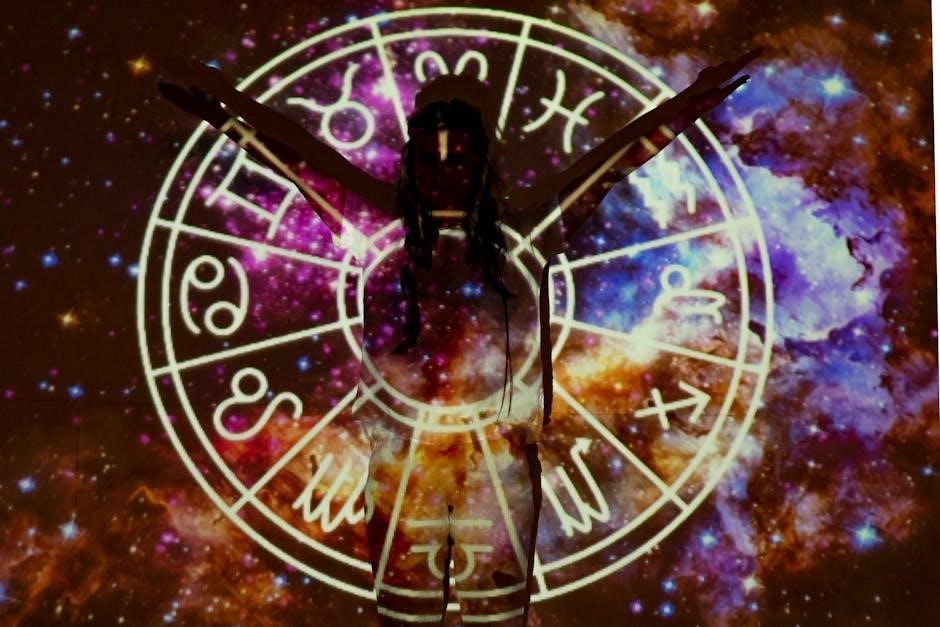
Carlos Fuentes’ 1962 novel Aura is a seminal work in Latin American literature, exploring themes of identity and the supernatural. Its PDF version is widely available for download and study, making it accessible for scholarly analysis and readers interested in magical realism.
1.1 Overview of the Novel “Aura”
Aura, a novella by Carlos Fuentes, published in 1962, is a captivating blend of reality and fantasy. The story follows Felipe Montero, a young historian hired by the enigmatic Consuelo to organize her late husband’s memoirs. As Felipe delves deeper, he uncovers a mysterious connection between Consuelo, her husband, and the elusive Aura. The novel explores themes of identity, time, and memory through its intricate narrative structure and magical realism. Fuentes’ masterful storytelling weaves historical elements with supernatural occurrences, creating a unique reading experience. Aura is celebrated for its profound exploration of human consciousness and the blurred lines between past and present. The novella’s PDF version is widely available, making it accessible to readers worldwide for deeper study and appreciation.
1.2 Carlos Fuentes and His Literary Significance
Carlos Fuentes, a prominent Mexican novelist, played a pivotal role in the Latin American Boom, a literary movement that revolutionized narrative techniques. Known for works like The Death of Artemio Cruz and Terra Nostra, Fuentes blended historical, political, and cultural themes with magical realism. His writing often explored identity, power, and the complexities of human experience. Aura, one of his earlier works, showcases his ability to weave intricate storytelling with philosophical depth. Fuentes’ contributions to literature earned him global acclaim and numerous awards, solidifying his legacy as a master of contemporary Latin American fiction. His works, including Aura, remain widely studied and admired, with the novel’s PDF version ensuring its accessibility to new generations of readers.
1.3 Importance of “Aura” in Latin American Literature
Aura holds a significant place in Latin American literature as a masterpiece of magical realism. Published in 1962, it exemplifies the innovative narrative styles of the Boom movement, influencing many writers. The novel’s exploration of identity, memory, and the supernatural resonates deeply, making it a cornerstone of the region’s literary heritage. Its availability in PDF format has facilitated its dissemination, ensuring that scholars and readers worldwide can engage with Fuentes’ profound work. This accessibility has contributed to the enduring relevance of Aura, allowing it to remain a vital text in understanding the evolution of Latin American literary traditions and their global impact.

Plot Summary
Felipe Montero, a young historian, is hired by the enigmatic Consuelo to organize her late husband’s memoirs. As he delves into the task, he uncovers a mysterious aura surrounding Consuelo and the general, blurring reality and fantasy.
2.1 The Story of Felipe Montero
Felipe Montero, a young historian, is employed by the enigmatic Consuelo to organize the memoirs of her late husband, a former general. Intrigued by the opportunity, Felipe accepts the position, unaware of the mysterious aura surrounding Consuelo and her deceased spouse. As he begins his work, he discovers a complex web of secrets and supernatural elements intertwined with the general’s past. Felipe’s journey into the heart of this enigmatic household reveals themes of obsession, identity, and the blurring of reality and fantasy. His character serves as a vessel for the reader to explore the deeper psychological and philosophical layers of the narrative. Through Felipe’s experiences, Fuentes masterfully crafts a tale that challenges perceptions of time, memory, and human desire.
2.2 The Mysterious Consuelo and the General
Consuelo, an elderly and enigmatic woman, hires Felipe Montero to organize her late husband’s memoirs. Her presence is shrouded in mystery, and her relationship with the General is deeply complex. The General, a figure of authority and secrecy, casts a long shadow over the narrative. Consuelo’s obsession with her husband’s past and her own identity creates an aura of intrigue. As Felipe delves deeper, he uncovers layers of manipulation and supernatural undertones surrounding the General’s legacy. Consuelo’s role as both guardian of the past and architect of the present blurs the lines between reality and illusion. Her character embodies the themes of obsession and the enduring power of memory, making her a central enigma in the story.
2.3 The Supernatural Elements in the Narrative
The narrative of Aura is deeply intertwined with supernatural elements, creating an eerie and mystical atmosphere. The presence of Consuelo and the General is accompanied by ghostly apparitions and unexplained phenomena. Felipe Montero’s experience in the ancient, labyrinthine house heightens the sense of the unknown. The supernatural is not merely a backdrop but a driving force in the story, blurring the lines between reality and fantasy. Fuentes masterfully weaves elements of horror and enchantment, leaving readers questioning what is real and what is imagined. The supernatural underscores the themes of obsession, memory, and the inexorable pull of the past, making it a central element of the novella’s haunting beauty and intellectual depth.

Themes
Love, obsession, identity, reality vs. fantasy, and time/memory are central themes in Aura, exploring human complexity and the blurred lines between past and present, truth and illusion.
3.1 Love and Obsession
In Aura, love and obsession are deeply intertwined, creating a complex web of emotions. Felipe Montero’s fascination with Consuelo and Aura reflects the destructive power of desire. The novel portrays love not as a redemptive force but as a possessive and haunting experience. Obsession transcends reality, blurring the lines between past and present. Through Felipe’s descent into madness, Fuentes illustrates how all-consuming passion can lead to self-destruction. The PDF version of the novel highlights these themes, offering readers a profound exploration of human vulnerability and the darker aspects of love.

3.2 Identity and Self-Discovery
Felipe Montero’s journey in Aura is a profound exploration of identity and self-discovery. As he becomes entangled in the mysterious world of Consuelo and the enigmatic Aura, Felipe’s sense of self begins to unravel. The novel delves into the psychological transformation of its protagonist, revealing how his interactions with these characters challenge his perceptions of reality and his place within it. Through his descent into the labyrinth of the past and the supernatural, Felipe confronts the fragility of his own identity. The interplay between his rational, academic self and the irrational, emotional experiences he undergoes underscores the complexity of self-discovery. Ultimately, the novel suggests that identity is a fluid and ever-changing construct, shaped by memory, desire, and the blurring of boundaries between reality and fantasy.
3.3 The Interplay of Reality and Fantasy
In Aura, Carlos Fuentes masterfully explores the interplay between reality and fantasy, creating a narrative that seamlessly blends the two. The novel’s use of magical realism allows the reader to experience a world where the rational and the irrational coexist. Felipe Montero’s encounters with the enigmatic Consuelo and the mysterious Aura challenge his perception of what is real and what is imagined. The house, with its labyrinthine structure and haunting atmosphere, serves as a physical manifestation of this blurred boundary. The narrative’s fluid transition between historical fact and supernatural elements underscores the fragility of reality. This interplay not only heightens the sense of mystery but also invites the reader to question the nature of truth and perception, making Aura a compelling exploration of the human experience.
3.4 Time and Memory
Carlos Fuentes’ Aura delves deeply into themes of time and memory, creating a narrative rich with historical and personal reflection. The protagonist, Felipe Montero, becomes entangled in the past through his work with Consuelo, uncovering memories that blur the line between present and past. The novel’s non-linear structure and use of magical realism emphasize the fluidity of time, where the past and present coexist. Memory is portrayed as both a burden and a source of understanding, shaping the characters’ identities. The General’s journals and the haunting presence of Aura serve as tools to explore how memory constructs reality. This exploration of time and memory not only enriches the narrative but also highlights the enduring impact of the past on the human experience, making Aura a profound meditation on history and personal legacy.

Literary Elements
Carlos Fuentes employs magical realism, non-linear narrative structures, and rich symbolism in Aura, blending historical and fantastical elements to create a captivating and layered storytelling experience.
4.1 Magical Realism in “Aura”
In Aura, Carlos Fuentes masterfully integrates magical realism, blending the mundane with the supernatural. The novel’s atmosphere seamlessly shifts between reality and fantasy, creating a captivating narrative. The character of Consuelo and the mysterious Aura exemplify this blend, as their lives intertwine with elements of the paranormal. Fuentes’ use of magical realism not only enhances the story’s depth but also explores deeper themes such as identity and the blurring of time. This literary technique, characteristic of the Boom movement, makes Aura a standout work in Latin American literature, offering readers a unique and enchanting reading experience that challenges conventional storytelling norms.
4.2 Narrative Structure and Style
Carlos Fuentes employs a non-linear narrative structure in Aura, weaving together past and present through the protagonist Felipe Montero’s experiences. The story unfolds in a first-person narrative, creating an intimate and immersive connection with the reader. Fuentes’ prose is dense and lyrical, rich with imagery that enhances the novel’s supernatural and psychological dimensions. The narrative’s complexity is heightened by its fluid transitions between reality and fantasy, mirroring the blurred boundaries in the characters’ lives. This unique storytelling approach contributes to the novel’s enigmatic and dreamlike atmosphere, making it a hallmark of Fuentes’ literary style and a key element in the exploration of identity and memory.
4.3 Use of Symbolism
In Aura, Carlos Fuentes masterfully employs symbolism to enrich the narrative’s depth and thematic complexity. The house, with its labyrinthine structure, symbolizes entrapment and the weight of the past, reflecting Felipe’s psychological confinement. Mirrors, recurring throughout the novel, serve as portals to hidden truths and the blurring of reality and illusion, emphasizing the supernatural elements. The portrait of Aura, a central symbol, embodies the enigmatic and timeless presence of the titular character, representing both beauty and obsession. These symbols, along with others, create a layered exploration of identity, memory, and the interplay between the tangible and the unknown, showcasing Fuentes’ ability to weave profound meanings into the fabric of his storytelling.

Symbolism
Aura by Carlos Fuentes is rich in symbolic elements that explore themes of identity, memory, and the supernatural. The house and mirrors serve as metaphors for illusion and reality.
5.1 The House as a Symbol
The house in Aura serves as a central symbol, representing both confinement and the past. Its labyrinthine structure mirrors the protagonist’s psychological journey, reflecting themes of isolation and the blurring of reality and fantasy. The house is also a repository of memories, holding the secrets of Consuelo and the General, which Felipe uncovers. This physical space symbolizes the entrapment of the characters in their own histories and desires, while also functioning as a bridge between the living and the dead. Through its decaying grandeur, the house embodies the transience of time and the weight of unresolved pasts, making it a powerful and evocative symbol in Fuentes’ narrative.
5.2 The Mirror and Its Significance
The mirror in Aura is a pivotal symbolic element, serving as a portal to the supernatural and a reflection of the characters’ inner truths. It bridges the gap between reality and fantasy, allowing Felipe to glimpse the enigmatic Aura and the haunting presence of Consuelo. The mirror’s role is both revelatory and deceptive, uncovering hidden desires while blurring the lines between past and present. Its significance lies in its ability to manifest the duality of identity, particularly in Consuelo and Aura, who are intertwined through time and memory. The mirror becomes a catalyst for Felipe’s obsession and his descent into the mysterious world of the General’s house, symbolizing the fragility of human perception and the enduring power of the unknown.
5.3 The Portrait of Aura
The portrait of Aura is a central symbolic element in Carlos Fuentes’ Aura, serving as a visual manifestation of the enigmatic and timeless figure at the heart of the novel. The portrait captures Aura’s ethereal beauty and her haunting presence, which transcends time and reality. It becomes a focal point for Felipe Montero’s obsession, drawing him into a world of mystery and illusion. The portrait also symbolizes the intertwining of past and present, as Aura’s image seems to bridge the gap between the General’s memories and Felipe’s experiences. Through the portrait, Fuentes explores themes of identity, memory, and the supernatural, creating a sense of ambiguity that leaves readers questioning what is real and what is imagined. The portrait’s significance is further amplified by its role in Felipe’s transformation, as he becomes increasingly entangled in the enigmatic world of Aura and Consuelo.

Character Analysis
Felipe Montero is a quiet, introspective archivist entangled in a web of mystery. Consuelo, the manipulative matriarch, orchestrates events with hidden motives. Aura, the elusive figure, embodies the transcendental and unknown.
6.1 Felipe Montero: The Protagonist
Felipe Montero is the central figure in Carlos Fuentes’ Aura, a young historian employed by the enigmatic Consuelo to organize her late husband’s memoirs. His introverted nature and academic diligence are juxtaposed with the surreal events unfolding around him. As he delves deeper into the General’s past, Felipe becomes entangled in a world where reality and fantasy blur. His character serves as a lens through which the reader navigates the complexities of identity, memory, and obsession. Montero’s quiet demeanor contrasts with the intense emotional and supernatural forces that surround him, making him both relatable and a vessel for the novel’s deeper themes.
6.2 Consuelo: The Enigmatic Figure
Consuelo is the elderly matriarch who employs Felipe Montero to organize her late husband’s memoirs. Her enigmatic presence dominates the narrative, as she exudes both mystery and authority. Consuelo’s motivations are shrouded in ambiguity, and her connection to the supernatural elements of the story is profound. Through her interactions with Felipe, it becomes clear that she harbors secrets tied to the General and Aura, which slowly unravel as the story progresses. Her character represents a blend of tradition, power, and the occult, making her a pivotal figure in the novel’s exploration of identity and reality. Consuelo’s influence over Felipe and the eerie environment of the house underscores her central role in the unfolding drama;
6.3 Aura: The Mysterious Woman
Aura is the enigmatic and captivating figure at the heart of Carlos Fuentes’ novel. Her presence is both haunting and alluring, blending the lines between reality and fantasy. As Felipe Montero becomes entangled in her world, Aura’s true nature gradually reveals itself, exposing a complex web of identity, time, and memory. Her character embodies the supernatural elements of the story, challenging Felipe’s perceptions and drawing him into a labyrinth of obsession and discovery. Through Aura, Fuentes explores themes of love, transformation, and the blurred boundaries between past and present. Her mysterious allure makes her one of the most compelling and unforgettable characters in contemporary Latin American literature, leaving a lasting impact on readers and scholars alike.

Historical Context
Carlos Fuentes’ Aura, published in 1962, reflects Mexico’s cultural and political shifts during the mid-20th century, a period of significant transformation and literary innovation.
7.1 The Boom Movement in Latin American Literature
The Boom Movement, flourishing in the 1960s and 1970s, revolutionized Latin American literature, introducing innovative narrative styles and thematic depth. Carlos Fuentes, alongside authors like Gabriel García Márquez and Mario Vargas Llosa, was a central figure, with works like Aura embodying the movement’s essence. Aura, published in 1962, blends magical realism with psychological complexity, reflecting the Boom’s experimentation with form and its exploration of identity, history, and fantasy. The novel’s availability in PDF format has made it accessible to global readers, ensuring its influence endures. This period marked a cultural renaissance, positioning Latin American literature on the world stage and cementing Fuentes’ legacy as a literary giant.
7.2 Mexico’s Cultural and Political Landscape
Mexico’s cultural and political landscape during the mid-20th century was marked by post-revolutionary transformation and a growing national identity. Carlos Fuentes, deeply rooted in this context, explored themes of history, memory, and cultural heritage in Aura. The novel reflects Mexico’s struggle to reconcile its colonial past with modernity, as seen in the decaying mansion and the enigmatic figures of Consuelo and the General. Fuentes’ work critiques societal structures and the role of individuals within them, resonating with Mexico’s political climate of the 1960s. The PDF availability of Aura has allowed readers to engage with these themes digitally, preserving the novel’s relevance in understanding Mexico’s cultural evolution during this pivotal era.

Reception and Reviews
Aura received critical acclaim upon its release in 1962, praised for its unique blend of magical realism and psychological depth. Readers and scholars continue to explore its complexities, while the availability of the PDF version has made it accessible to a broader audience, ensuring its enduring relevance in contemporary literary discussions.
8.1 Initial Reception of the Novel
When Aura was first published in 1962, it garnered significant attention for its unique narrative style and exploration of the supernatural. Critics praised its blend of magical realism and psychological depth, hailing it as a groundbreaking work in Latin American literature. The novel’s ability to weave together elements of horror and beauty, drawing comparisons to authors like Poe and Baudelaire, resonated with readers. Its concise yet powerful structure made it a standout piece during the Boom movement. The PDF version of Aura has since become a popular resource for scholars and enthusiasts, ensuring its enduring relevance. Initial reviews highlighted its innovative storytelling and thematic complexity, solidifying Carlos Fuentes’ reputation as a literary giant.
8.2 Modern Relevance and Interpretations
Today, Aura remains a captivating and thought-provoking novel, with modern readers and scholars continuing to explore its complex themes and narrative techniques. The PDF version of the book has made it more accessible, allowing new generations to engage with Fuentes’ unique storytelling. Contemporary interpretations often highlight the novel’s exploration of identity, memory, and the blurred lines between reality and fantasy. Its blend of psychological depth and supernatural elements resonates with modern audiences, who appreciate its haunting beauty and philosophical undertones. The availability of Aura in digital formats has also spurred fresh analyses, ensuring its relevance in the digital age. As a result, the novel continues to be celebrated as a masterpiece of Latin American literature, offering timeless insights into the human condition.

Availability of “Aura” in PDF Format
The PDF version of Carlos Fuentes’ Aura is accessible through multiple online platforms, offering various formats for download, including SINGLE PAGE PROCESSED JP2 ZIP files, ensuring easy accessibility for readers.
9.1 Sources for Downloading the PDF
The PDF version of Aura by Carlos Fuentes is available through various online platforms. The Internet Archive offers a downloadable PDF, along with a SINGLE PAGE PROCESSED JP2 ZIP file. Additionally, Google Books provides partial previews, and specific academic databases may offer full access. Independent websites and forums also share links for free downloads, though users should verify the legitimacy and quality of such sources. The novel is available in multiple languages, including English and Arabic translations, catering to a global audience. These sources ensure that readers can easily access and engage with Fuentes’ critically acclaimed work.
9.2 Challenges in Accessing the PDF
Accessing the PDF of Aura by Carlos Fuentes can present several challenges. While the novel is widely available, some sources may offer incomplete or low-quality versions. Certain platforms require subscriptions or payments, limiting free access. Additionally, copyright restrictions in specific regions may hinder direct downloads, forcing users to rely on secondary sources. The availability of translated versions, such as the Arabic edition, may also vary, potentially leading to inconsistent quality or formatting. Users must ensure they download from reputable sites to avoid malware or unreliable files. These obstacles highlight the need for caution and discernment when seeking the PDF online.